

Dementia-friendly environments - health.vic. Sight-line.pdf. Bio-adaptive Lighting. Inclusive Designs Ltd. Www.studiearena.nl/uploads/1302_Dementievriendelijke_Architectuur_en_Inrichting/gesine_marquardt_.pdf. Design_Principles_for_Extra_Care_July_2004.pdf. Living Well with Dementia Design Challenge. Launched in 2011, Living Well with Dementia was a Design Challenge run in partnership with the Department of Health, to improve the lives of those affected by dementia.
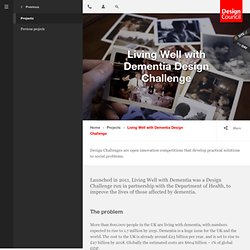
The problem More than 800,000 people in the UK are living with dementia, with numbers expected to rise to 1.7 million by 2051. Dementia is a huge issue for the UK and the world. The cost to the UK is already around £23 billion per year, and is set to rise to £27 billion by 2018. Globally the estimated costs are $604 billion – 1% of global GDP. The insight We felt we could use the Design Challenge process to turn the rising costs associated with dementia in an ageing population into an opportunity for positive change and innovation. Our response We launched a 12 month Design Challenge in partnership with Department of Health, the aim: to design and develop products and services that rethink living with dementia, and launch them as real initiatives.
The results. Housing our Ageing Population: Plan for Implementation (HAPPI2) Report (2012) - Resource library - Learn and Improve. The All Party Parliamentary Group (APPG) on Housing and Care for Older People, chaired by Lord Best, has highlighted the benefits of improved housing options for older people.
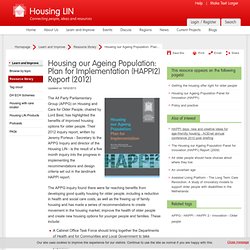
Their 2012 inquiry report, written by Jeremy Porteus - Secretary to the APPG Inquiry and director of the Housing LIN - is the result of a five month inquiry into the progress in implementing the recommendations and design criteria set out in the landmark HAPPI report. The APPG inquiry found there were far reaching benefits from developing good quality housing for older people, including a reduction in health and social care costs, as well as the freeing up of family housing and has made a series of recommendations to create movement in the housing market, improve the health of older people and create new housing options for younger people and families.
These include: Www.kingsfund.org.uk/sites/files/kf/EHE-dementia-assessment-tool.pdf. Convention.eurac.edu/NR/rdonlyres/0F74661B-F545-4C81-9447-45C3E1F48F72/22338/Marquardt_Gesine.pdf. Www.normbau-extranet.de. What can go wrong. Www.informedesign.org/_news/april_v07r-pr.2.pdf. Webarchive.nationalarchives.gov.uk/20110118095356/http:/www.cabe.org.uk/files/a-bibliography-of-design-value.pdf. Building Houses or Creating Communities? · Sustainable Development Commission.
In its first thematic review, the SDC scrutinises the Sustainable Communities Plan, launched by the Labour Government in 2003.
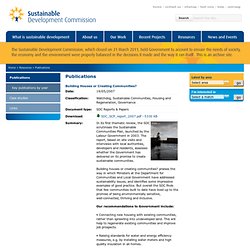
The report, based on site visits and interviews with local authorities, developers and residents, assesses whether the Government has delivered on its promise to create sustainable communities. Building houses or creating communities? Praises the way in which Ministers at the Department for Communities and Local Government have addressed sustainability issues, and identifies some impressive examples of good practice. But overall the SDC finds that few communities built to date have lived up to the promise of being environmentally sensitive, well-connected, thriving and inclusive. Our recommendations to Government include: Wandering in Familiar Spaces. What we need to question is bricks, concrete, glass, our table manners, our utensils, our tools, the way we spend our time, our rhythms, to question that which seems to have ceased forever to astonish us.

We live, true, we breathe, true, we walk, we open doors, we go down staircases, we sit at a table in order to eat, we lie down on a bed in order to sleep, how? Where? When? Why? Georges Perec, 1973 The ‘Wandering In Familiar Spaces’ website has been created as part of my masters project at the Mackintosh School of Architecture, Glasgow. This led me to reassess my personal understanding of disability and its place in developing inclusive environments. After 2,000 years, courtyard houses are all the rage again. Augusta Raurica/via Courtyard houses made a lot of sense.
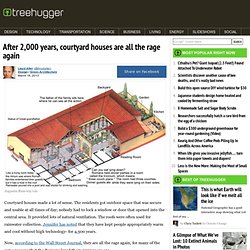
The residents got outdoor space that was secure and usable at all times of day; nobody had to lock a window or door that opened into the central area. It provided lots of natural ventilation. The roofs were often used for rainwater collection. Inclusive Design Toolkit Home. Gesine Marquardt Designing for pwd. Independent Assistive Living Showcase: Video Tour (Subtitled) Virtual Dementia Tour. Designing and Adapting the Living Environment for People with dementia - Design - Dementia - Browse by topic - Learn and Improve - Homepage - Housing LIN.
Barcelona Design Week 2010: Designs For Dementia Make It Easier To Eat (Photos) Plate with high-lipped profile helps push food onto the spoon.

Image Credit: "Design for Dementia", Gregor Timlin & Nic Rysenbry, Royal College of Art Helen Hamlyn Centre Around 700,000 people in the UK have dementia, over a third of which live in care homes, according to the Royal College of Art Helen Hamlyn Centre which focuses on people-centered design research. Eating and drinking, getting dressed and other daily actions become a critical issue when people are affected by dementia (a serious loss of cognitive ability). Independence and dignity are at risk but don't have to suffer if the correct tools are available, to address the challenges of advanced aging.
New Dynamics of Ageing. Design for Dementia - Helen Hamlyn Centre. Gregor Timlin and Nic Rysenbry, Research Associates 2010 Research Partner Bupa RCA Department.
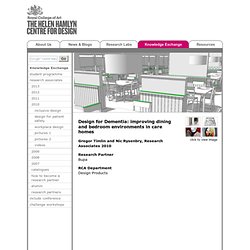
Designing For Dementia Sufferers. Country Sample basket View Basket Sorry, Page not found Unfortunately the page or content you we're trying to view is either missing or caused an error.

You could return to the home page and try again or choose from one of the main sections from the list below. Alternatively, please try the search function for a more specific page. Designing and managing care homes for people with dementia. Download as PDF 0.1 MB March 2002 - Ref 312 Designing and managing care homes for people with dementia The proportion of residents in care homes who have dementia is rising.
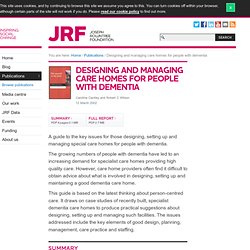
DementiaDesignInfo.com: Welcome. A searchable database which summarizes the dementia design literature Search by: Space (bedroom, bathing area, etc.) and/or User need (privacy, safety, etc.) and/or Environmental scale (building layout, design details, etc.)

Search results link specific environmental characteristics or features with behavioral, experiential and/or organizational outcomes. Outcomes are validated by research, reflect expert consensus or are recognized as best practices. Visuoperceptual difficulties in dementia. Download a PDF of Sight, perception and hallucinations in dementia People with dementia may experience problems with their sight which cause them to misinterpret the world around them. Age related hearing loss. Www.innovationsindementia.org.uk/DementiaFriendlyCommunities/Dementia-friendly Environmental checklists.pdf.
Julian Treasure: Why architects need to use their ears.